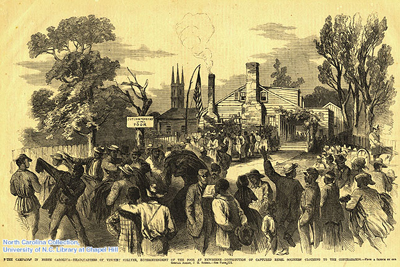Vincent Colyer
Featured Character – 1863

The
Campaign in North Carolina—Headquarters of
Vincent Collyer, Superintendent of the Poor at Newberne—Distribution of
Captured Rebel Soldier’s Clothing to the Contraband.” Frank
Leslie’s Illustrated Newspaper, June 14, 1862.
Courtesy of the North Carolina
Collection, University of North Carolina at Chapel Hill Library
Born in 1824 to recently arrived
English immigrants, Vincent Colyer grew up in rural New York.
At the age of eight, Colyer’s father died during a cholera outbreak,
leaving the family destitute. Although
he wanted to become an artist, Coyler worked in a store to support his widowed
mother and six siblings. At the age of
nineteen, he quit work to study under noted American painter John R.
Smith. With Smith’s tutelage, Coyler became
a great landscape artist highly influenced by the Hudson River School.
He also firmly believed in abolition,
even painting a picture of John Brown.
As a member of the Young Men’s Christian Association, Coyler organized
the United States Sanitary Commission.
Following his invasion of North
Carolina, Ambrose Burnside made Coyler superintendent
of the poor, responsible for the welfare of escaped slaves. On Roanoke Island,
Coyler set up the Freedmen’s Colony and the first school in the state for the
education of black people. In his
capacity as superintendent of the poor, Coyler wrote a highly influential
report, Report of the Services Rendered by the Freed People to the United
States Army in North Carolina, in the Spring of 1862, After the Battle of
Newbern, that spurred the creation of the Freedmen’s Bureau. He later served as the colonel of a black
regiment. As a member of the Board of
Indian Commissioners under President Ulysses S. Grant, Coyler traveled
extensively in the American West and Alaska. Critics consider his drawings and paintings
from that journey as some of the best nineteenth century images of the western United States. Vincent Coyler died in Rowayton, Connecticut
on July 12, 1888.
